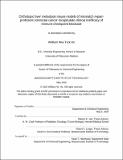Orthotopic liver metastasis mouse models of mismatch repair-proficient colorectal cancer recapitulate clinical inefficacy of immune checkpoint blockade
Author(s)
Ho, William Wee Teck.
Download1262872171-MIT.pdf (1.624Mb)
Other Contributors
Massachusetts Institute of Technology. Department of Chemical Engineering.
Advisor
Rakesh K. Jain and Robert S. Langer.
Terms of use
Metadata
Show full item recordAbstract
Liver metastasis is a major cause of mortality in patients with colorectal cancer (CRC). Immune checkpoint blockade (ICB) therapy has significantly improved overall survival in several cancer types including melanoma and non-small cell lung cancer. However, patients with mismatch repair-proficient (pMMR) metastatic CRC do not respond to ICB therapy. MC38 and CT26 are two of the most commonly used mouse syngeneic CRC cell lines in preclinical studies of colorectal cancer. In most of these preclinical studies, MC38 and CT26 are implanted under the skin in the hind flank of the mice where they grow into subcutaneous tumors. Several studies have shown that these subcutaneous MC38 or CT26 tumors respond very well to ICB treatment. However, MC38 and CT26 have been reported previously to be pMMR CRC cell lines, indicating that these subcutaneous tumor mouse models do not recapitulate the clinical reality well. In this thesis, we show that when pMMR CRC cell lines are implanted orthotopically in the liver as liver metastasis, the resultant liver metastases are unresponsive to ICB, which recapitulates the clinical reality that patients with pMMR metastatic CRC do not respond to ICB treatment. We further show that when treated with ICB, these orthotopic pMMR CRC liver metastasis mouse models have poor infiltration and activation of key immune cells and significantly decreased activity of key pathways that are critical for the efficacy of ICB. We also evaluated several strategies aimed at overcoming the inefficacy of ICB in these pMMR CRC liver metastasis mouse models. We found that radiation therapy was able to overcome inefficacy of ICB in the pMMR CRC liver metastasis mouse model with moderately low tumor mutational load. We also found that antibody-peptide epitope conjugates (APECs) were able to increase the efficacy of ICB in the pMMR CRC liver metastasis mouse model with very low tumor mutational load. Our results demonstrate that by implanting pMMR CRC cell lines in a relevant tissue site such as in the liver to model CRC liver metastasis, we can more accurately recapitulate the clinical efficacy of therapies such as ICB.
Description
Thesis: Ph. D., Massachusetts Institute of Technology, Department of Chemical Engineering, May, 2020 Cataloged from the official PDF of thesis. Includes bibliographical references (pages 70-75).
Date issued
2020Department
Massachusetts Institute of Technology. Department of Chemical EngineeringPublisher
Massachusetts Institute of Technology
Keywords
Chemical Engineering.